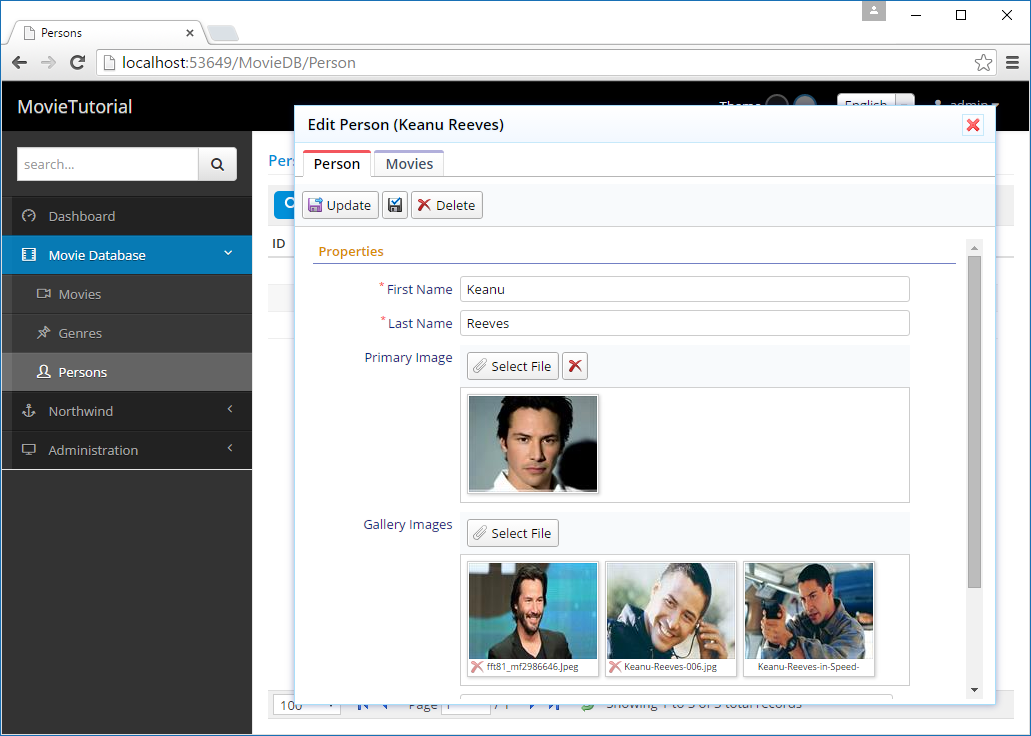Adding Primary and Gallery Images
To add a primary image and multiple gallery images to both Movie and Person records, need to start with a migration:
using FluentMigrator;
using System;
namespace MovieTutorial.Migrations.DefaultDB
{
[Migration(20151115202100)]
public class DefaultDB_20151115_202100_PrimaryGalleryImages : Migration
{
public override void Up()
{
Alter.Table("Person").InSchema("mov")
.AddColumn("PrimaryImage").AsString(100).Nullable()
.AddColumn("GalleryImages").AsString(Int32.MaxValue).Nullable();
Alter.Table("Movie").InSchema("mov")
.AddColumn("PrimaryImage").AsString(100).Nullable()
.AddColumn("GalleryImages").AsString(Int32.MaxValue).Nullable();
}
public override void Down()
{
}
}
}
Then modify MovieRow.cs and PersonRow.cs:
namespace MovieTutorial.MovieDB.Entities
{
// ...
public sealed class PersonRow : Row, IIdRow, INameRow
{
[DisplayName("Primary Image"), Size(100),
ImageUploadEditor(FilenameFormat = "Person/PrimaryImage/~")]
public string PrimaryImage
{
get { return Fields.PrimaryImage[this]; }
set { Fields.PrimaryImage[this] = value; }
}
[DisplayName("Gallery Images"),
MultipleImageUploadEditor(FilenameFormat = "Person/GalleryImages/~")]
public string GalleryImages
{
get { return Fields.GalleryImages[this]; }
set { Fields.GalleryImages[this] = value; }
}
// ...
public class RowFields : RowFieldsBase
{
// ...
public readonly StringField PrimaryImage;
public readonly StringField GalleryImages;
// ...
}
}
}
namespace MovieTutorial.MovieDB.Entities
{
// ...
public sealed class MovieRow : Row, IIdRow, INameRow
{
[DisplayName("Primary Image"), Size(100),
ImageUploadEditor(FilenameFormat = "Movie/PrimaryImage/~")]
public string PrimaryImage
{
get { return Fields.PrimaryImage[this]; }
set { Fields.PrimaryImage[this] = value; }
}
[DisplayName("Gallery Images"),
MultipleImageUploadEditor(FilenameFormat = "Movie/GalleryImages/~")]
public string GalleryImages
{
get { return Fields.GalleryImages[this]; }
set { Fields.GalleryImages[this] = value; }
}
// ...
public class RowFields : RowFieldsBase
{
// ...
public readonly StringField PrimaryImage;
public readonly StringField GalleryImages;
// ...
}
}
}
Here we specify that these fields will be handled by ImageUploadEditor and MultipleImageUploadEditor types.
FilenameFormat specifies the naming of uploaded files. For example, Person primary image will be uploaded to a folder under App_Data/upload/Person/PrimaryImage/.
~ at the end of FilenameFormat is a shortcut for the automatic naming scheme {1:00000}/{0:00000000}_{2}.
Here, parameter {0} is replaced with identity of the record, e.g. PersonID.
Parameter {1} is identity / 1000. This is useful to limit number of files that stored in one directory.
Parameter {2} is a unique string like 6l55nk6v2tiyi, which is used to generate a new file name on every upload. This helps to avoid problems caused by caching on client side.
Thus, a file we upload for person primary image will be located at a path like this:
> App_Data\upload\Person\PrimaryImage\00000\00000001_6l55nk6v2tiyi.jpg
You don't have to follow this naming scheme. You can specify your own format like
PersonPrimaryImage_{0}_{2}.
Next step is to add these fields to forms (MovieForm.cs and PersonForm.cs):
namespace MovieTutorial.MovieDB.Forms
{
//...
public class PersonForm
{
public String Firstname { get; set; }
public String Lastname { get; set; }
public String PrimaryImage { get; set; }
public String GalleryImages { get; set; }
public DateTime BirthDate { get; set; }
public String BirthPlace { get; set; }
public Gender Gender { get; set; }
public Int32 Height { get; set; }
}
}
namespace MovieTutorial.MovieDB.Forms
{
//...
public class MovieForm
{
public String Title { get; set; }
[TextAreaEditor(Rows = 3)]
public String Description { get; set; }
[MovieCastEditor]
public List<Entities.MovieCastRow> CastList { get; set; }
public String PrimaryImage { get; set; }
public String GalleryImages { get; set; }
[TextAreaEditor(Rows = 8)]
public String Storyline { get; set; }
public Int32 Year { get; set; }
public DateTime ReleaseDate { get; set; }
public Int32 Runtime { get; set; }
public Int32 GenreId { get; set; }
public MovieKind Kind { get; set; }
}
}
I also modified Person dialog css a bit to have more space:
.s-PersonDialog {
> .size { .widthAndMin(700px); .heightAndMin(600px); }
.dialog-styles(@h: auto, @l: 150px, @e: 450px);
.s-PropertyGrid .categories { height: 460px; }
.ui-dialog-content { overflow: hidden; }
.tab-pane.s-TabMovies { padding: 5px; }
.s-PersonMovieGrid > .grid-container { height: 515px; }
}
This is what we get now:

ImageUploadEditor stores file name directly in a string field, while MultipleImageUpload editor stores file names in a string field with JSON array format.